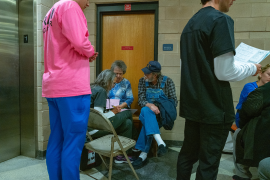In state FY2009, Colorado Medicaid implemented a pay-for-performance (P4P) program for nursing facilities, with financial incentives tied to both quality-of-care and quality-of-life measures. A first-year evaluation suggests that it succeeded in stimulating culture change in nursing homes. State budget constraints and a cap on the annual nursing facility provider fee have resulted in the cancellation of P4P payments for applications submitted in the year ended June 30, 2010, but the model Colorado developed may serve as a blueprint that could be replicated in other states and could be reinstated in Colorado, as budgets permit.
"The application [for the P4P program] itself is almost a manual or set of instructions on how to implement cultural change in a [nursing] home," said Richard Gallagher, long term benefits acting operations section manager, Colorado Department of Health Care Policy and Financing, in a 2010 report issued to the Department of Health Care Policy and Financing by the Public Consulting Group.
Implemented by the Colorado Department of Health Care Policy and Financing (HCPF), the program was developed with input from a range of public and private stakeholders. Its implementation oversight board included the state's Ombudsman, HCPF, nursing home providers, the state nursing facilities contract auditor, and the Colorado Foundation for Medical Care.
About half of the nursing homes in the state participated in the voluntary P4P program, and applications were increasing over the year. Medicaid paid up to $3 per Medicaid resident per day as an add-on to basic daily rates. To qualify, the facility submitted a Nursing Facility Pay for Performance Application 2010 to HCPF with self-reported scores, quantitative survey results, and other supportive documentation. A total of 100 points were assigned to numerous metrics (Table 1). Forty-nine points out of 100 were tied to quality-of-life metrics such as enhanced bathing experience, choice in dining time and menu, consistent assignment, and other measures designed to create a home-like environment (Table 2). Fifty-one points were related to quality-of-care metrics. A nursing home that scored 75 points would receive $2 per Medicaid resident per day, or about $39,000 for a year, based on average Medicaid occupancy.1
Table 1. Per Diem Rate Add-On
Points |
Per Diem Add-On |
0–20 |
$0 |
21–45 |
$0 |
46–60 |
$1 |
61–79 |
$2 |
80–100 |
$3 |
A provider fee on nursing homes provided the source of state funding for the incentive payments, which were matched by federal Medicaid dollars. Total spending on the incentive payments for state FY2009 was approximately $2.5 million. For state FY2010, the combination of the cap on the nursing facility provider fee and the state's general fund limitation reduced the ability to fund the new reimbursement system components. Although the nursing facility provider fee was still assessed, no monies from it were available to fund the P4P program.
Table 2. Colorado Nursing Home Measures tied to P4P Points
Quality of Life |
Quality of Care |
Resident-Directed Care: · Enhanced Dining · Flexible and Enhanced Bathing · Daily Schedules · End-of-Life Program |
General Quality of Care: · 12 Hours Continuing Education · 14 Hours Continuing Education · 16 Hours Continuing Education · Quality Program Participation |
Home Environment: · Resident Rooms · Public and Outdoor Space · Overhead Paging · Neighborhoods/Households |
Nationally Reported Quality Measures: · High-Risk Pressure Ulcers · Chronic Care Pain Score · Physical Restraints · Falls · UTIs · Staff Influenza Immunization |
Relationships with Staff, Family, Resident, and Community: · 50% Consistent Assignments · 80% Consistent Assignments · Internal Community · External Community · Living Environment · Volunteer Program |
Facility Management · 10% Medicaid above State Average · 5% Medicaid above State Average |
Staff Empowerment: · Care Planning · Career Ladders/Career Paths · Person-Directed Care · New Staff Program |
Staff Stability: · Staff Retention Rate · Staff Retention Improvement · Director of Nursing Retention · Nursing Home Administrator Retention · Employee Satisfaction Survey |
The response to the P4P program from nursing homes was generally positive; some said that they were finally getting rewarded for what they were doing in the first place. For others, the incentives encouraged innovative ways to give residents more choices and comfort, and to reduce waste. For example, consistent assignment—assigning staff to care for the same residents regularly—"strengthens relationships, improves continuity of care, and also lowers staff turnover," said Amy Elliot, policy analyst of the Pioneer Network and program evaluation consultant.
The financial rewards then allow the facilities to do even more for the residents. "The extra dollars allow the homes to do more innovative quality-of-care and quality-of-life programs, as well as other improvements, and this gives them a competitive advantage over others. It's a great spiral that builds up," said John Brammeier, CFO of Piñon Management, Inc. and treasurer of the Colorado Health Association, which represents about 85 percent of Colorado's nursing homes.2 "We believe in this pay-for-performance reimbursement system and remain hopeful it will come back."
HCPF contracted with the Public Consultant Group to evaluate the program by assessing the validity of the self-reported scores, understanding of measures, and types and sufficiency of documentation and to make recommendations for improvements. Its 2009 report recommended that HCPF: provide more detailed instructions to nursing homes, ensure consideration of case-mix in scoring criteria, develop a Web site reporting P4P outcomes and scoring data, and improve training and education on the P4P program. The assessment concluded that despite some problems with documentation, the reviews and home visits indicated that "the performance measures have successfully stimulated homes to change their culture."
For more information, contact: Richard Gallagher at [email protected].
1 Public Consulting Group, Nursing Facility Pay-for-Performance Application Review (for applications submitted 1/31/09), June 30, 2009.
2 Piñon Management, Inc., provides management and consulting services to long-term care facilities.


